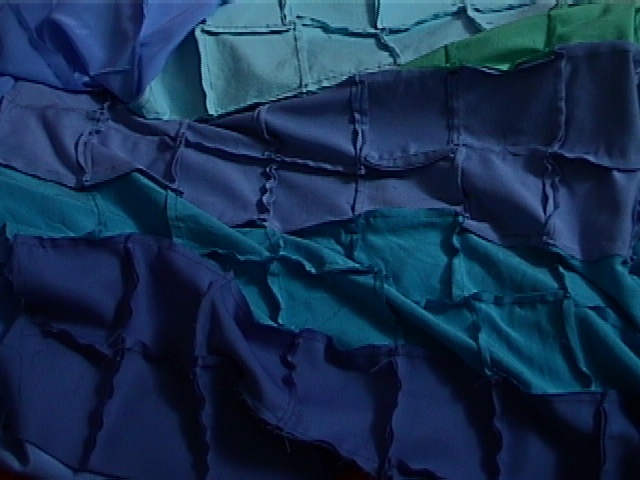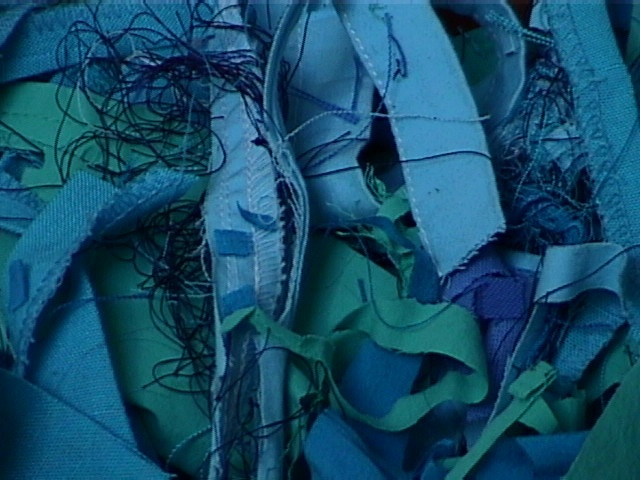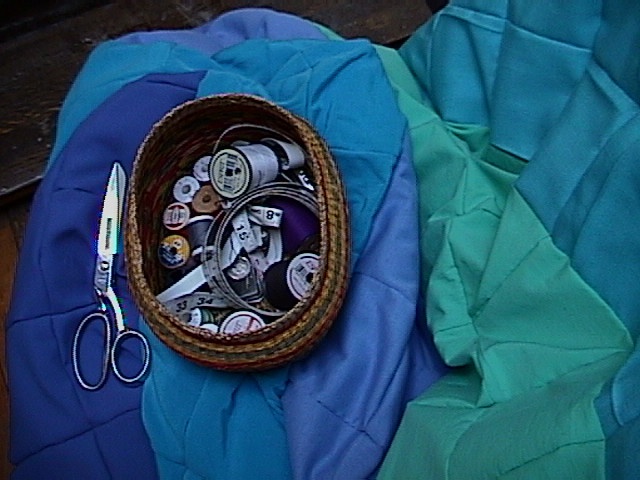Women Artist Links General Art Links Moira Fogarty's Projects Joyce Wieland
Domestic: Dreams of Duty



Project 2: Domestic
Dreams of Duty
"I got into looking around in history for female lines of influence.
I read the lives and works of many, many women, salonists, diarists, revolutionaries, etc.
I started to invent myself as an artist."
Joyce Wieland, to Kay Armatage
Artist's Statement:
This is my now completed Domestic project, called Dreams of Duty. A 150-piece quilt in seven different colours and fabrics forms the central focus of this piece, which features an accompanying sound recording and related objects. Visually speaking, the assemblage is chaotic, in spite of the soothing shades of blue that form the work. The quilt is an untidy jumble on the bottom of the assemblage, turned inside-out, to reveal the seams and loose threads, like opening up a clock to see the gears and cogs that make it work. On top of this are scatted the detritus, the leftover scraps of fabric, the trimmings and snippets of thread that were sacrificed to make the geometric precision of the final object. Inside the reversed quilt are the cotton batting that would normally be contained in the quilt, and a cassette player, recording the sounds of the sewing machine working to make the quilt. The piece addresses issues of domestic endeavour in contemporary life, as a construct of the ideals of the past and the realities of the present.
The Method Behind the Madness:
The Inside-Out Quilt - I started out making this quilt as only one of a number of objects which I intended to display in opposition to one another (see Ideas... below) but quickly realized that the quilt was an enormous task in and of itself. The selection of the fabrics, which include silk, polyester, denim, acrylic and cotton, the meticulous measuring and cutting and ironing of the pieces, and the interminable pinning and sewing took weeks of labour. During this process, I came to appreciate how much work goes unnoticed and unappreciated in the construction of clothing and in other art labelled craft which is traditionally women's work. As a modern woman I have lost the skills and knowledge that I would traditionally have been trained in in favour of an academic education, and it was amazing to realize the distance that separates me from my grandmother in terms of life experience.
The Detritus - Including all the scraps and snips of fabric and thread, the empty spools, the broken pins and discarded patterns seemed integral to the idea that emerged as the quilt came together. As the actual object itself developed into a smooth geometric plane with even gradations of colour, the contrasting pile of waste left behind grew proportionately larger. It is these lost bits that came to represent the unseen hours of labour that domestic work demands, and I decided to scatter tham over top of the finished, inside-out quilt to emphasize this invisible element.
The Instruction Manual - This 1960's Singer sewing machine manual functions to recall the whimsical side of this project, the dream of deomesticity often symobolized by the frou-frou fifties housewife that I have long held as an ideal I can never achieve in my own life. I included it because it makes a nice contrast to the textbooks I read as part of my university education, illustrated with brightly coloured pictures and step by step instructions. It is the manual my mother memorized as a young woman, and one that I learned awkwardly on my own. For me, it emphasizes the break in tradition and the history of domesticity that I have escaped from, but somehow yearn to return to.
The Recorded Sound - This is the only section of the work which is not two-dimensional. The rhythmic whirr of the sewing machine struck me as an important element to include in the display, as it communicates the process, the time involved in constructing even this very simple quilt. It also addresses the idea of domestic work as often being repetitive, cyclical and solitary, as the drone waxes and wanes, and is interrupted only by the punctuating snip of the thread.
Ideas That Fell By the Wayside:
I had hoped at first to use two sets of concrete, familiar images to locate the third, more elusive and changing definition of domesticity in modern life. Pulling the dream to earth, into reality, by weighing it down with objects from around the home, and by showing the difference between what really happens and what the mind imagines. The reality, I presume, lies in the gap between the two. To achieve this sense, I originally planned to arrange objects in a V formation, with four "dream" objects, all matching, all clean, all in soothing shades of blue, confronting four "real" objects, once blue but now corrupted and spoiled with red. The dream objects were: a quilt (warmth and comfort), oven mitts (baking), feather dusters (immaculate cleanliness), and clean ceramic plates (hot meals). The reality objects were: dirty dishes, rusting SOS pads, socks with holes in them, and a microwave dinner covered in ketchup. I still think this arrangement would have worked out well, and would have communicated my concept adequately, but my early work inconstructing the quilt for this assemblage of objects evolved in such a way as to reveal a different method of presentation.
Questions, comments, suggestions or criticisms?
Mail them to me at moira.fogarty@utoronto.ca
Personal Influences
Doug Sensei School Heritage Parents Broccoli Olivia Garden Home Japan Music Tori
Tom Dave Madness Maya Lin Northern Exposure
What are man and woman if not members of two very different and warring tribes? Yet decade after decade, century after century, they attempt in marriage to reconcile and forge a union. Why? I don't know. Biological imperative? Divine law? Or just a desire to connect to that mysterious other? In any case, it's always struck me as a hopeful thing.
--- Bernard Caillebotte
people have visited this site since its creation February 1st, 2000.